Grower Average Salary in Muscat 2024
How much money does a person working as Grower make in Muscat?

LOW
260
OMR AVERAGE
560
OMR HIGH
880
OMR
A person working as Grower in Muscat typically earns around 560 OMR. Salaries range from 260 OMR (lowest) to 880 OMR (highest).
Salary Variance
This is the average salary including housing, transport, and other benefits. Grower salaries in Muscat vary drastically based on experience, skills, gender, or location. Below you will find a detailed breakdown based on many different criteria.
Grower Pay Scale and Salaries in Muscat
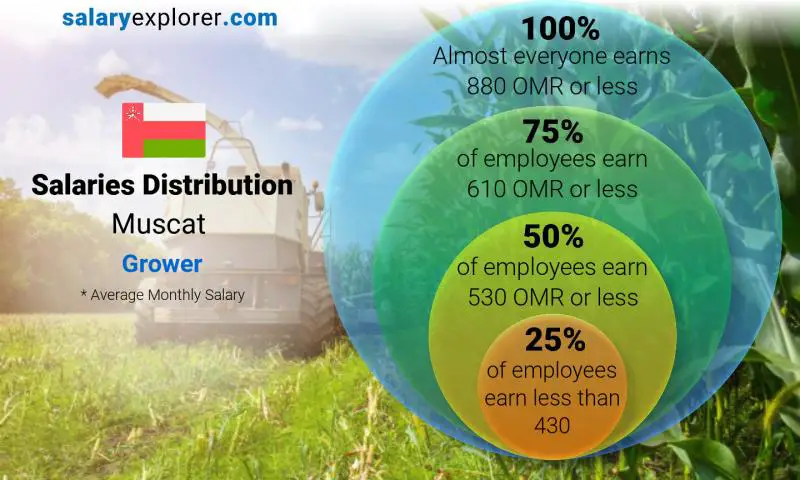
Salary Structure and Pay Scale Comparison
530 OMR or more
460 to 530 OMR
320 OMR or less
320 to 460 OMR
 260 OMR |
 530 OMR |
 880 OMR |
Median Salary, maximum and minimum salary, minimum wage, starting salary, and the salary range
Salary Range, Minimum Wage, and Starting Salary
Salaries for the position Grower in Muscat range from 260 OMR (starting salary) to 880 OMR (maximum salary). It should be noted that the given figure is not the legally mandated minimum wage; rather, it represents the lowest figure reported in a salary survey that included thousands of participants and professionals from all regions of the country.
Median Salary
With a median salary of 530 OMR, half of the professionals who work as Grower in Muscat earn less than this amount, and the other half earn more. The median salary denotes the middle value of salaries. Ideally, you would want to belong to the group earning more than the median salary, located on the right side of the salary distribution graph.
Percentiles and Salary Scale
The median is closely associated with two other values known as the 25th and 75th percentiles. By examining the salary distribution chart, it can be determined that 25% of professionals employed as Grower in Muscat earn less than 430 OMR, while 75% earn more. Similarly, the chart shows that 75% earn less than 610 OMR while 25% earn more.
Pay Scale Structure
To provide a better understanding of expected salaries, we categorized the frequently occurring salaries into different ranges. This approach provides a more precise representation of salary distribution for the job title Grower in Muscat compared to simply calculating the average. The majority of reported salaries, approximately 65%, fall within the range of 320 OMR to 460 OMR. About 20% of salaries are below the 320 OMR mark, while 10% fall within the range of 460 OMR to 530 OMR. Only 5% of individuals have salaries exceeding 530 OMR.
Salary Comparison by Years of Experience / Grower / Muscat
How do experience and age affect pay?
| 0 - 2 Years | 300 OMR | |
| 2 - 5 Years | +38% | 420 OMR |
| 5 - 10 Years | +42% | 590 OMR |
| 10 - 15 Years | +22% | 720 OMR |
| 15 - 20 Years | +6% | 760 OMR |
| 20+ Years | +9% | 830 OMR |
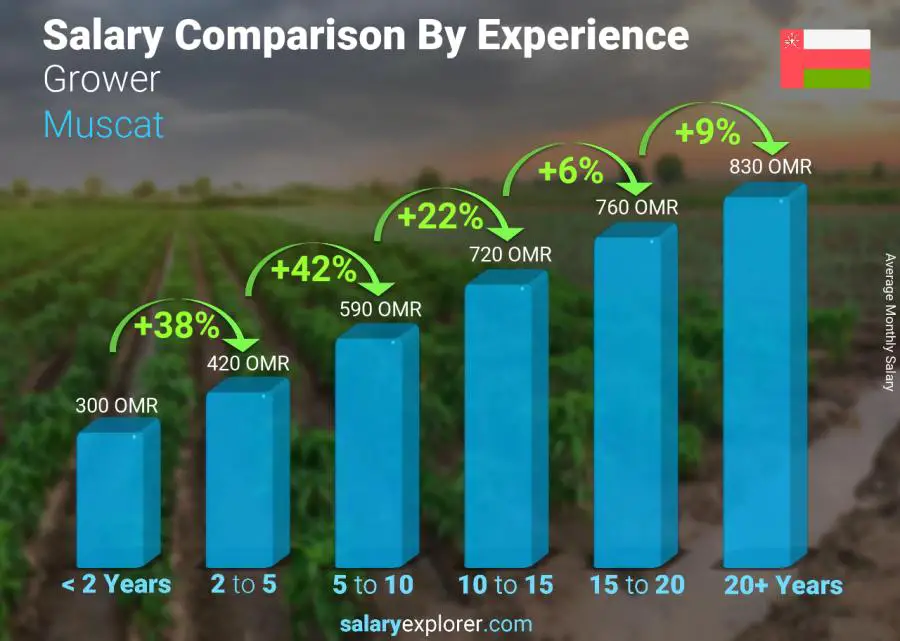
The experience level is the most important factor in determining the salary. Naturally, the more years of experience the higher the wage. We broke down salaries by experience level for people working as Grower and this is what we found.
Employees with less than two years of experience earn approximately 300 OMR.
While someone with an experience level between two and five years is expected to earn 420 OMR, 38% more than someone with less than two year's experience.
Moving forward, an experience level between five and ten years lands a salary of 590 OMR, 42% more than someone with two to five years of experience.
Additionally, professionals whose expertise span anywhere between ten and fifteen years get a salary equivalent to 720 OMR, 22% more than someone with five to ten years of experience.
If the experience level is between fifteen and twenty years, then the expected wage is 760 OMR, 6% more than someone with ten to fifteen years of experience.
Lastly, employees with more than twenty years of professional experience get a salary of 830 OMR, 9% more than people with fifteen to twenty years of experience.
Typical Salary Progress for Most Careers
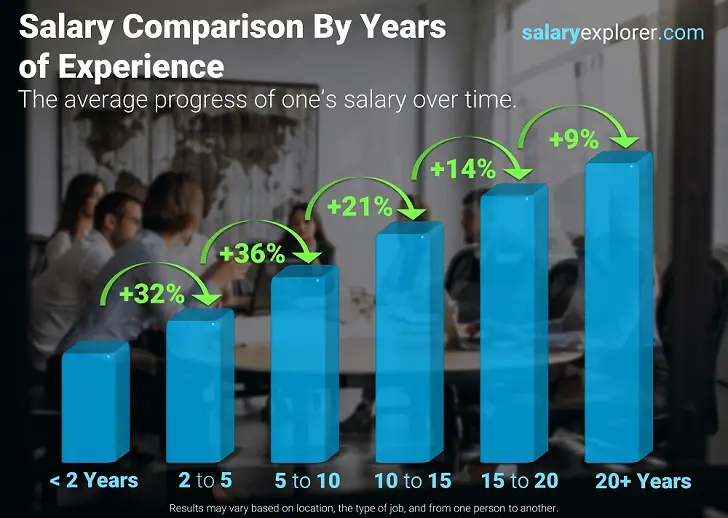
Salary Comparison By Education / Grower / Muscat
How do education levels affect salaries?
Displayed below is the average salary variance between different education levels of professionals working as Grower.
| High School | 380 OMR | |
| Certificate or Diploma | +81% | 690 OMR |
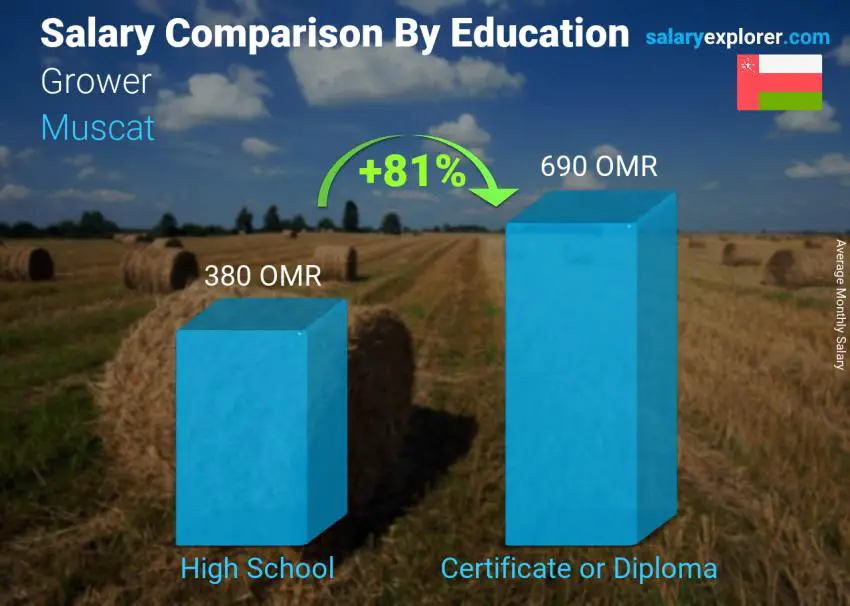
We all know that higher education equals a bigger salary, but how much more money can a degree add to your income? We broke down salaries by education level for the position Grower in order to make a comparison.
Level 1: High School
Employees at this education level have an average salary of 380 OMR.
Level 2: Certificate or Diploma
At this level, the average salary becomes 690 OMR, 81% more than the previous level.
Typical Salary Difference by Education for Most Careers

Salary and Compensation Comparison By Gender / Grower / Muscat
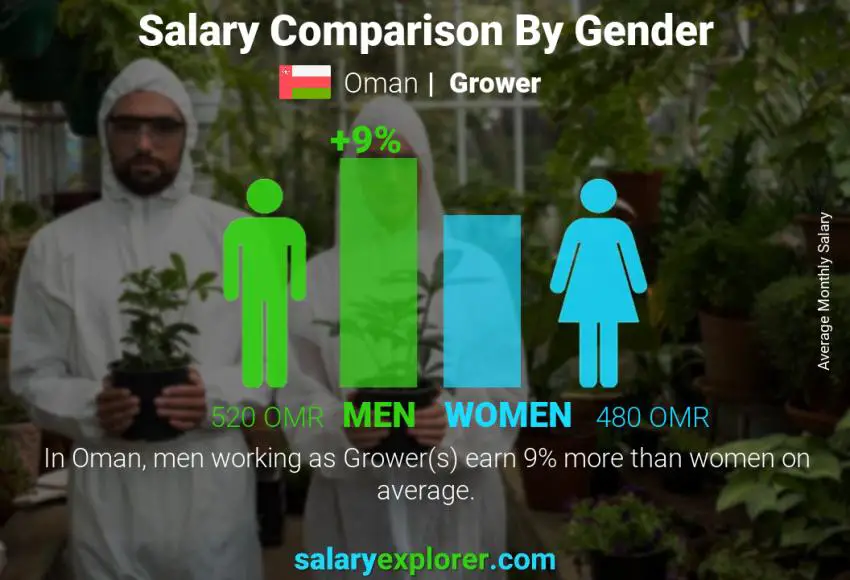
Though gender should not have an effect on pay, in reality, it does. So who gets paid more: men or women? For the people who work as Grower in Oman, the average difference between the salary of male and female employees is 9%.
| Male | 520 OMR | |
| Female | -8% | 480 OMR |
Salary Comparison By Gender in Oman for all Careers
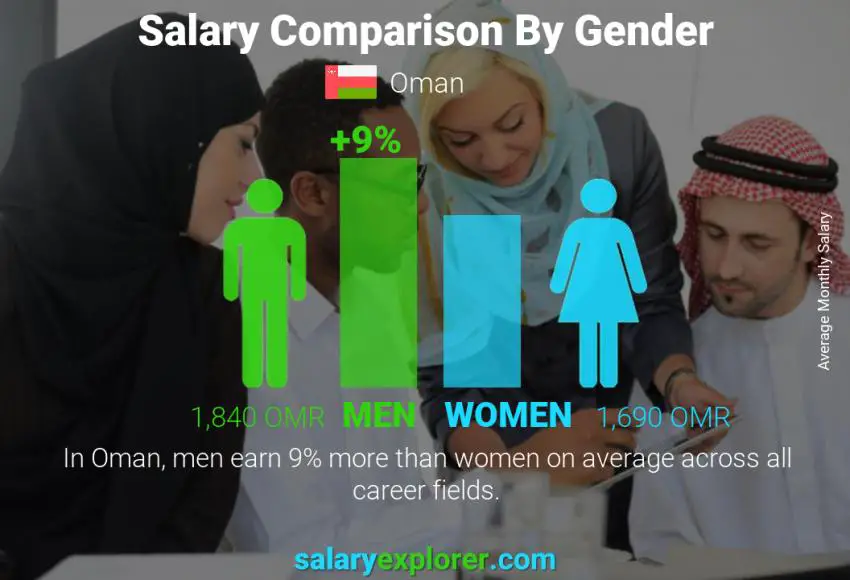
Average Annual Salary Increment Percentage / Grower / Muscat
How much are annual salary increments in Muscat for individuals working as Grower? How often do employees get salary raises?
Individuals working as Grower in Oman are likely to observe a salary increase of approximately % every months. The national average annual increment for all professions combined is 7% granted to employees every 19 months.
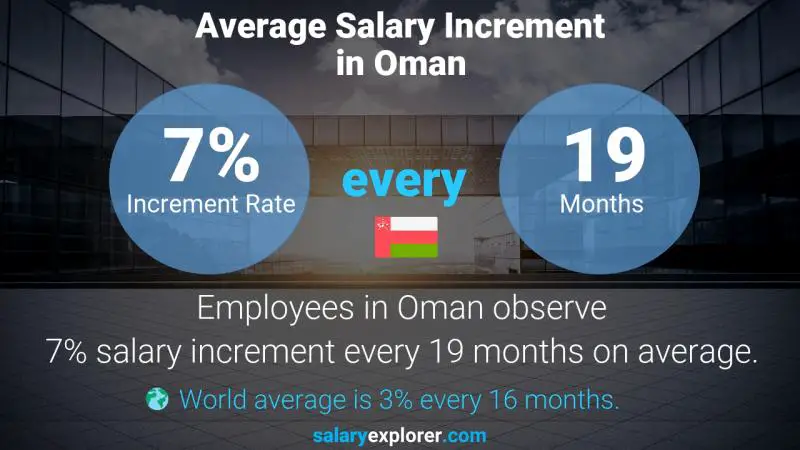
Oman / All Professions
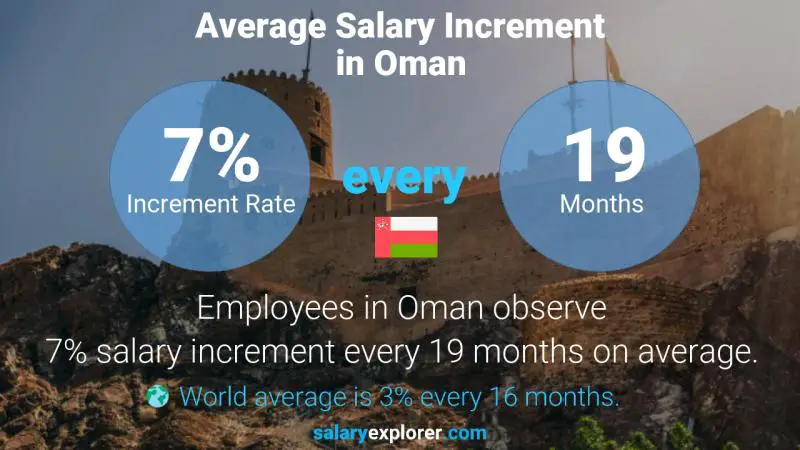
The term Annual Salary Increase usually refers to the increase in 12 calendar month period, but because it is rare that people get their salaries reviewed exactly on the one-year mark, it is more meaningful to know the frequency and the rate at the time of the increase.
How to calculate the salary increment percentage?
The annual salary Increase in a calendar year (12 months) can be easily calculated as follows: Annual Salary Increase = Increase Rate x 12 / Increase Frequency
Worldwide Salary Raises: All Countries and All Jobs

Salary Packages and Schemes
Not all compensation increases are reflected directly in the salary. Some companies offer upgraded packages to their staff instead of cash money. The figures displayed here account only for direct increments to the base salary.
Bonus and Incentive Rates / Grower / Oman
How much and how often are bonuses being awarded?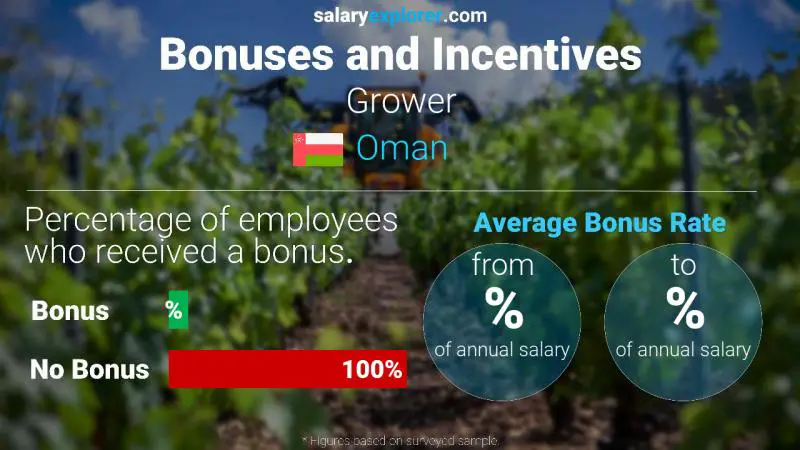 Share This Chart Tweet Get Chart Linkhttp://www.salaryexplorer.com/charts/oman/gardening-farming-fishing/grower/annual-salary-bonus-rate-oman-grower.jpg
Share This Chart Tweet Get Chart Linkhttp://www.salaryexplorer.com/charts/oman/gardening-farming-fishing/grower/annual-salary-bonus-rate-oman-grower.jpg
100% of surveyed staff reported that they haven't received any bonuses or incentives in the previous year while % said that they received at least one form of monetary bonus.
Those who got bonuses reported rates ranging from % to % of their annual salary.
| Received Bonus | % | |
| No Bonus | 100% |
Types of Bonuses Considered
Individual Performance-Based BonusesThe most standard form of bonus, where the employee is awarded based on their exceptional performance.
Company Performance BonusesOccasionally, some companies like to celebrate excess earnings and profits with their staff collectively in the form of bonuses that are granted to everyone. The amount of the bonus will probably be different from person to person depending on their role within the organization.
Goal-Based BonusesGranted upon achieving an important goal or milestone.
Holiday / End of Year BonusesThese types of bonuses are given without a reason and usually resemble an appreciation token.
Bonuses Are Not Commissions!
People tend to confuse bonuses with commissions. A commission is a prefixed rate at which someone gets paid for items sold or deals completed while a bonus is in most cases arbitrary and unplanned.
What makes a position worthy of good bonuses and a high salary?
The main two types of jobs | |
| Revenue Generators | Supporting Cast |
Employees that are directly involved in generating revenue or profit for the organization. Their field of expertise usually matches the type of business. | Employees that support and facilitate the work of revenue generators. Their expertise is usually different from that of the core business operations. |
Example: | Example: |
Revenue generators usually get more and higher bonuses, higher salaries, and more frequent salary increments. The reason is quite simple: it is easier to quantify your value to the company in monetary terms when you participate in revenue generation.
Bonus Comparison by Seniority Level
Top management personnel and senior employees naturally exhibit higher bonus rates and frequencies than juniors. This is very predictable due to the inherent responsibilities of being higher in the hierarchy. People in top positions can easily get double or triple bonus rates than employees down the pyramid.
Average Hourly Wage / Grower / Muscat
 3 OMR per hour
3 OMR per hourThe average hourly wage (pay per hour) for individuals working as Grower in Muscat is 3 OMR.This is the rate they get paid for every worked hour.
About The Hourly Pay Rate
The hourly wage is the salary paid in one worked hour. Usually, jobs are classified into two categories: salaried jobs and hourly jobs. Salaried jobs pay a fixed amount regardless of the hours worked. Hourly jobs pay per worked hour. To convert salary into hourly wage the above formula is used (assuming 5 working days in a week and 8 working hours per day which is the standard for most jobs). The hourly wage calculation may differ slightly depending on the worked hours per week and the annual vacation allowance. The figures mentioned above are good approximations and are considered to be the standard. One major difference between salaried employees and hourly paid employees is overtime eligibility. Salaried employees are usually exempt from overtime as opposed to hourly paid staff.
What is the minimum hourly rate of pay?
The minimum pay rate per hour for people working as Grower in Muscat is 2 OMR. This is the minimum as per the gathered data in the salary survey not the minimum hourly rate mandated by law.
Salary comparison with similar jobs
| Job Title | Average Salary |
| Gardening / Farming / Fishing |  -100% -100% | |
| Agri-Tourism Manager | 2,310 OMR |  +310% +310% |
| Agricultural and Food Science Technician | 1,110 OMR |  +99% +99% |
| Agricultural and Food Scientist | 2,650 OMR |  +380% +380% |
| Agricultural Consultant | 2,650 OMR |  +380% +380% |
| Agricultural Engineer | 1,720 OMR |  +210% +210% |
| Agricultural Inspector | 1,670 OMR |  +200% +200% |
| Agricultural Manager | 2,860 OMR |  +410% +410% |
| Agroforestry Specialist | 1,540 OMR |  +180% +180% |
| Agronomist | 2,430 OMR |  +340% +340% |
| Algal Biotechnologist | 1,790 OMR |  +220% +220% |
| Animal Attendant | 860 OMR |  +54% +54% |
| Animal Nutritionist | 1,530 OMR |  +170% +170% |
| Animal Trainer | 1,030 OMR |  +85% +85% |
| Aquaculture and Seafood Farmer | 920 OMR |  +65% +65% |
| Aquaponics Engineer | 1,600 OMR |  +190% +190% |
| Aquaponics Technician | 1,410 OMR |  +150% +150% |
| Aquatic Ecologist | 1,840 OMR |  +230% +230% |
| Bee Keeper | 560 OMR |  +1% +1% |
| Beekeeper Educator | 920 OMR |  +65% +65% |
| Commercial Horticulturist | 1,290 OMR |  +130% +130% |
| Community Supported Agriculture Coordinator | 910 OMR |  +63% +63% |
| Compost Technician | 710 OMR |  +27% +27% |
| Conservation Agent | 920 OMR |  +65% +65% |
| Diver | 860 OMR |  +54% +54% |
| Edible Landscaping Designer | 1,120 OMR |  +100% +100% |
| Farm Manager | 2,290 OMR |  +310% +310% |
| Farmer | 600 OMR |  +8% +8% |
| Fish Hatchery Technician | 600 OMR |  +8% +8% |
| Floral Designer | 730 OMR |  +31% +31% |
| Food Waste Reduction Specialist | 1,230 OMR |  +120% +120% |
| Forage Consultant | 1,250 OMR |  +120% +120% |
| Foreman | 460 OMR |  -17% -17% |
| Forestry and Logging Worker | 480 OMR |  -14% -14% |
| Garden Center Helper | 500 OMR |  -10% -10% |
| Garden Centre Manager | 1,410 OMR |  +150% +150% |
| Gardener | 540 OMR |  -3% -3% |
| General Farm Assistant | 520 OMR |  -7% -7% |
| Greenhouse Assistant | 540 OMR |  -3% -3% |
| Greenhouse Manager | 1,280 OMR |  +130% +130% |
| Groundsman | 530 OMR |  -5% -5% |
| Grower | 560 OMR |  +1% +1% |
| Guerrilla Gardener | 910 OMR |  +63% +63% |
| Horticultural Worker | 520 OMR |  -7% -7% |
| Hydroponic Facility Manager | 1,600 OMR |  +190% +190% |
| Hydroponic Farmer | 780 OMR |  +40% +40% |
| Hydroponic Farming Infrastructure Installer | 1,370 OMR |  +150% +150% |
| Hydroponic Systems Engineer | 1,490 OMR |  +170% +170% |
| Mariculture Specialist | 1,430 OMR |  +160% +160% |
| Organic Farming Instructor | 1,170 OMR |  +110% +110% |
| Organic Farming Specialist | 1,360 OMR |  +140% +140% |
| Organic Seed Farmer | 840 OMR |  +51% +51% |
| Precision Agriculture Specialist | 1,050 OMR |  +89% +89% |
| Reef Restoration Technician | 950 OMR |  +71% +71% |
| Regenerative Agriculture Specialist | 1,300 OMR |  +130% +130% |
| Seaweed Farmer | 670 OMR |  +20% +20% |
| Sustainable Agriculture Consultant | 1,750 OMR |  +210% +210% |
| Sustainable Fisheries Manager | 1,660 OMR |  +200% +200% |
| Tree Pruner | 490 OMR |  -12% -12% |
| Tree Specialist | 840 OMR |  +51% +51% |
| Urban Agriculture Specialist | 1,830 OMR |  +230% +230% |
| Urban Farmer | 890 OMR |  +60% +60% |
| Urban Gardening Consultant | 1,280 OMR |  +130% +130% |
| Vertical Farming Specialist | 1,220 OMR |  +120% +120% |
| Vertical Garden Designer | 950 OMR |  +71% +71% |
Salary Comparison By City
| City | Average Salary |
| Muscat | 560 OMR |
Government vs Private Sector Salary Comparison
Where can you get paid more, working in a private company or the government? The difference between the public or government sector salaries and the private sector salaries in Oman is 7% on average across all career fields.
| Private Sector | 1,700 OMR | |
| Public Sector | +7% | 1,830 OMR |
Salary Statistics and Calculation Guide
What is considered to be a good and competitive salary for the job title Grower in Muscat?
A good and competitive compensation would range anywhere between 530 OMR and 610 OMR. This is a very rough estimate. Experience and education play a very huge part in the final earnings.
Gross Salary (before tax) and Net Salary (after tax)
All salary and compensation figures displayed here are gross salary figures, that is the salary before tax deductions. Because taxes may differ across sectors and locations, it is difficult to accurately calculate the net salary after tax for every career.
Base / Basic Salary
The base salary for a careers like Grower in Muscat ranges from 260 OMR to 430 OMR. The base salary depends on many factors including experience and education. It is not easy to provide a figure with very little information, so take this range with a grain of salt.
What is the difference between the median and the average salary?
Both are indicators. If your salary is higher than both the average and the median then you are doing very well. If your salary is lower than both, then many people earn more than you and there is plenty of room for improvement. If your wage is between the average and the median, then things can be a bit complicated. We wrote a guide to explain all about the different scenarios. How to compare your salary




